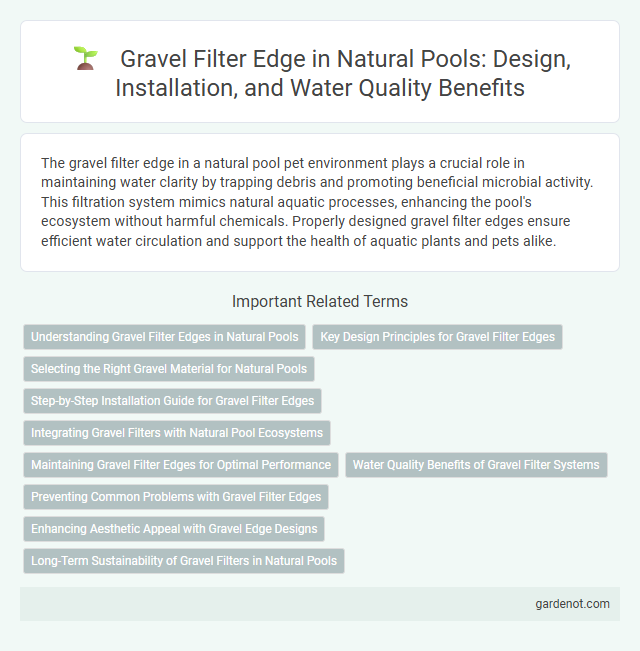The gravel filter edge in a natural pool pet environment plays a crucial role in maintaining water clarity by trapping debris and promoting beneficial microbial activity. This filtration system mimics natural aquatic processes, enhancing the pool's ecosystem without harmful chemicals. Properly designed gravel filter edges ensure efficient water circulation and support the health of aquatic plants and pets alike.
Understanding Gravel Filter Edges in Natural Pools
Gravel filter edges in natural pools serve as a critical biofiltration zone, where water passes through layers of gravel that trap debris and promote beneficial microbial activity essential for water purification. These edges function as a natural filtration barrier, supporting aquatic plants and microorganisms that break down organic matter and maintain the pool's ecological balance. Properly designed gravel filter edges enhance water clarity and contribute to the sustainable, chemical-free operation of natural swimming environments.
Key Design Principles for Gravel Filter Edges
Gravel filter edges in natural pools rely on permeable substrates to maintain water clarity by trapping debris and facilitating biological filtration. Effective designs emphasize proper gravel size gradation and layer depth to optimize water flow while preventing clogging and sediment infiltration. Integrating native plant roots within the gravel matrix enhances nutrient uptake and supports balanced aquatic ecosystems.
Selecting the Right Gravel Material for Natural Pools
Choosing the right gravel material for a natural pool's filter edge is critical for optimal water filtration and plant health. Coarse, rounded gravel such as basalt or quartz ensures efficient water flow and biological filtration by promoting beneficial microbial activity. Selecting gravel sizes between 8-16 mm balances permeability and stability, preventing clogging while supporting robust root systems for aquatic plants.
Step-by-Step Installation Guide for Gravel Filter Edges
To install a gravel filter edge for a natural pool, start by excavating a trench along the designated perimeter, ensuring a consistent depth and width to accommodate both the gravel and filter fabric. Lay down a geotextile filter fabric to prevent soil infiltration, then fill the trench with clean, washed gravel, compacting it firmly to create a stable, permeable barrier. Finish by securing the gravel edge with landscaping mesh or edging material to maintain shape and enhance filtration efficiency.
Integrating Gravel Filters with Natural Pool Ecosystems
Gravel filter edges play a crucial role in maintaining water clarity and supporting the biological balance within natural pool ecosystems. These filters facilitate microbial activity and natural filtration processes by providing a habitat for beneficial bacteria that break down organic matter and nutrients. Integrating gravel filters along the pool perimeter enhances water purification while preserving the aesthetic and ecological harmony of natural swimming environments.
Maintaining Gravel Filter Edges for Optimal Performance
Maintaining gravel filter edges in natural pools ensures efficient water filtration and prevents debris buildup that can hinder circulation. Regular removal of organic matter and periodic inspection for displacement help sustain optimal filtration performance. Proper upkeep of these edges promotes a healthy aquatic ecosystem and extends the longevity of the natural pool's filtration system.
Water Quality Benefits of Gravel Filter Systems
Gravel filter edges in natural pools enhance water quality by promoting efficient filtration through biological and mechanical processes. The porous structure of gravel supports beneficial microorganisms that break down organic contaminants, reducing algae growth and maintaining clear, clean water. By naturally removing impurities and balancing nutrient levels, gravel filter systems contribute to a healthier aquatic ecosystem and sustainable pool maintenance.
Preventing Common Problems with Gravel Filter Edges
A properly designed gravel filter edge in natural pools prevents common issues such as clogging, algae growth, and sediment buildup by ensuring efficient water flow and filtration. Using graded gravel sizes creates a stable barrier that traps debris while allowing water to pass through, reducing maintenance. Regular inspection and replenishment of gravel help maintain the filter's effectiveness and prolong the pool's ecosystem health.
Enhancing Aesthetic Appeal with Gravel Edge Designs
Gravel filter edges enhance natural pool aesthetics by providing a clean, rustic border that seamlessly integrates with surrounding landscaping. These designs create a visually appealing transition between water and land while promoting effective filtration and water circulation. Utilizing various gravel sizes and colors can enrich the pool's natural look and complement diverse garden styles.
Long-Term Sustainability of Gravel Filters in Natural Pools
Gravel filter edges in natural pools ensure long-term sustainability by promoting efficient biological filtration and maintaining water clarity without chemical additives. The porous structure of gravel supports beneficial microbial communities that break down organic matter, reducing nutrient buildup and preventing algal blooms. Properly maintained gravel filters can last for decades, minimizing environmental impact and preserving the ecosystem balance of natural swimming environments.
Gravel filter edge Infographic

 gardenot.com
gardenot.com